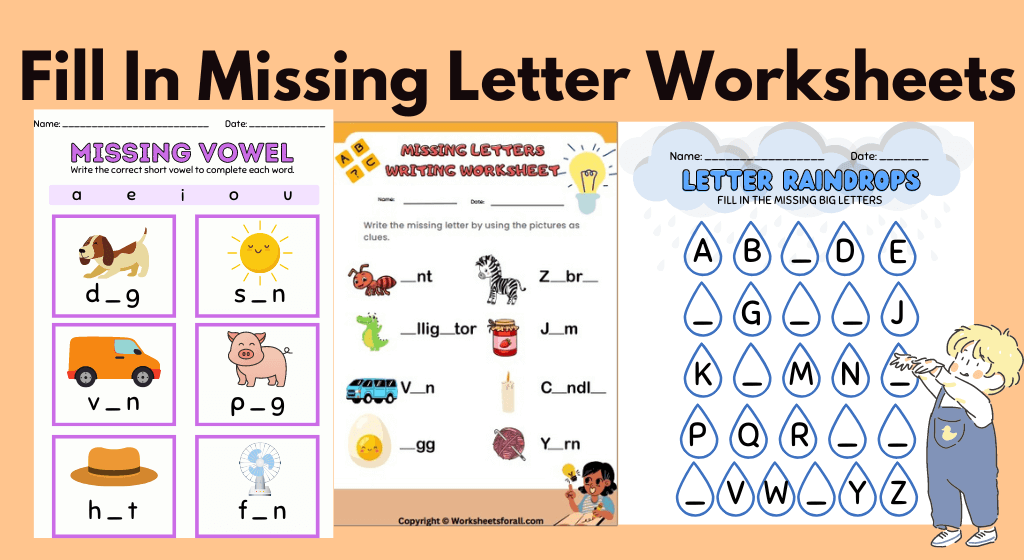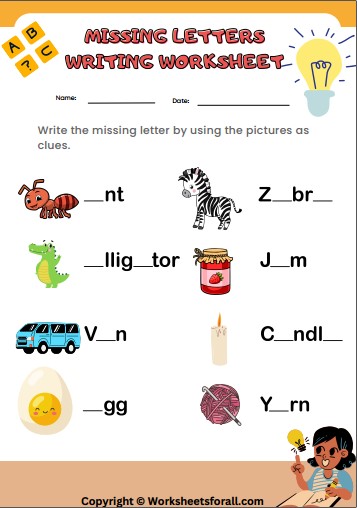Fill in Missing Letter Worksheets: The Best & Free Learning Tool
Updated: March 14, 2023
641

Among the many tools available, fill in missing letter worksheets are a powerful and versatile resource that can be used to develop a range of skills, from literacy to critical thinking. Fill in missing letter worksheets are designed to engage learners in a fun and interactive way by challenging them to fill in the missing letters in a word, phrase, or sentence. These free missing letter worksheets can be customized to suit the learner’s level, allowing them to progress at their own pace and build confidence as they learn.
Find The Missing Letter Worksheets
Benefits of Using Fill in Missing Letter Worksheets
Fill in missing letter worksheets are a versatile and effective learning tool that offer a range of benefits for learners of all ages. One of the key benefits of using these worksheets is that they improve spelling and writing skills. By challenging learners to spell words correctly and pay attention to the letters within each word, fill in missing letter worksheets help to improve spelling and writing skills, leading to better communication and language proficiency.
Another benefit of using fill in missing letter worksheets is that they enhance vocabulary. By requiring learners to fill in missing letters to complete words, these worksheets introduce new vocabulary and reinforce existing words. This leads to a broader vocabulary and improved language skills.
In addition, fill in missing letter worksheets also help to develop critical thinking skills. These worksheets require learners to use context clues to complete words, which encourages critical thinking and helps learners to develop problem-solving abilities.
Furthermore, fill in missing letter worksheets build confidence in learners by allowing them to work at their own pace and to progress from simpler to more complex worksheets. This leads to increased motivation and a greater desire to learn.
Lastly, fill in missing letter worksheets promote interactive learning. They are a great way to engage learners in interactive learning, which helps learners to stay interested and focused, making learning more enjoyable and effective.
In conclusion, fill in missing letter worksheets offer a range of benefits that make them a valuable learning tool for educators and learners alike. By improving spelling and writing skills, enhancing vocabulary, developing critical thinking skills, building confidence, and promoting interactive learning, these worksheets can help unlock learners’ full potential.
How to Use Fill in Missing Letter Worksheets
Using fill in missing letter worksheets is a straightforward process that can help learners improve their spelling, vocabulary, and critical thinking skills. Here are some steps to follow when using these worksheets:
First, choose a worksheet that is appropriate for the learner’s age and skill level. Fill in missing letter worksheets are available at different levels of difficulty, so it’s important to choose a level that will be challenging but not too difficult.
Once you have chosen the appropriate worksheet, introduce it to the learner. Explain what the worksheet is about and what they are expected to do. Make sure the learner understands the instructions before they begin.
Next, have the learner read the sentences or words on the worksheet and identify the missing letters. Encourage the learner to use context clues to help them figure out the missing letters. If the learner is struggling, provide hints or guidance to help them complete the worksheet.
After the learner has completed the worksheet, review their work with them. Praise them for their efforts and provide constructive feedback on areas where they can improve. Encourage the learner to keep practicing with fill in missing letter worksheets to continue improving their spelling and language skills.
Overall, using fill in missing letter worksheets is an effective way to help learners improve their language skills in a fun and engaging way. By choosing the appropriate level, introducing the worksheet, helping the learner identify missing letters, and reviewing their work, you can help learners develop their spelling, vocabulary, and critical thinking skills.
Variations of Fill in Missing Letter Worksheets
When we look at the kindergarten writing worksheets, fill in missing letter worksheets come in various forms, and it’s important to choose the right type for your learners. One popular variation is the word box worksheet, which presents words in a box and requires the learner to fill in the missing letters. This type of worksheet is great for developing spelling skills and reinforcing vocabulary.
Another variation is the sentence fill in missing letter worksheet, which presents a sentence with missing letters. Learners must fill in the missing letters to complete the sentence correctly. This type of worksheet is ideal for improving sentence construction, grammar, and punctuation skills.
A third variation of fill in missing letter worksheets is the story fill in missing letter worksheet. This type of worksheet presents a short story with missing letters, and learners must fill in the missing letters to complete the story. This type of worksheet is great for developing reading comprehension and critical thinking skills.
Finally, there are themed fill in missing letter worksheets, which present words or sentences related to a particular theme. For example, a Halloween-themed worksheet may present spooky words or sentences with missing letters. Themed worksheets are a great way to make learning fun and engaging.
In conclusion, fill in missing letter worksheets come in various forms, and each type offers unique benefits for learners. Choosing the right type of worksheet can help learners develop essential language skills and make learning more enjoyable.
Common Mistakes to Avoid When Using Fill in Missing Letter Worksheets
Using fill in missing letter worksheets can be a valuable learning tool for improving spelling, vocabulary, and critical thinking skills. However, there are common mistakes that learners and educators should avoid when using these worksheets.
One mistake is not choosing the appropriate level of difficulty. It’s important to choose a level that is challenging but not too difficult for the learner. Worksheets that are too easy may not be engaging or beneficial, while worksheets that are too difficult may be frustrating and discouraging.
Another mistake is not providing enough guidance or support. Learners may struggle to complete the worksheet on their own, so educators should provide guidance and support to help learners understand the instructions and identify missing letters.
Another mistake is not reviewing the completed worksheet thoroughly. It’s important to review the completed worksheet with the learner, providing praise for correct answers and constructive feedback on areas where improvement is needed. This helps learners understand where they went wrong and how they can improve their skills.
Finally, not using fill in missing letter worksheets regularly can hinder progress. Learners should use these worksheets regularly to reinforce spelling, vocabulary, and critical thinking skills. By using these worksheets regularly, learners can develop their language skills and improve their overall performance.
In conclusion, fill in missing letter worksheets are a valuable learning tool for improving spelling, vocabulary, and critical thinking skills. By avoiding common mistakes such as not choosing the appropriate level, not providing enough guidance, not reviewing the worksheet thoroughly, and not using the worksheets regularly, learners can get the most out of this learning tool.
Conclusion & Next Steps
My apologies for the confusion. Here’s a revised conclusion and next steps section for using fill in missing letter worksheets without any repetition:
In conclusion, fill in missing letter worksheets can be an excellent tool for improving spelling, vocabulary, and critical thinking skills. By engaging with these worksheets regularly, learners can build a strong foundation for future learning and enhance their overall academic performance.
To get the most out of fill in missing letter worksheets, it’s important to choose the appropriate level of difficulty and provide guidance and support to learners. Additionally, it’s crucial to review the completed worksheets thoroughly to offer constructive feedback and identify areas for improvement.
As the use of fill in missing letter worksheets becomes more popular, there are many resources available to help educators and learners alike. Online platforms offer a wide range of worksheets and activities that can be customized to suit different learning styles and skill levels. Furthermore, many educational institutions are incorporating fill in missing letter worksheets into their curriculum, which can provide learners with additional support and practice.
Next steps for using fill in missing letter worksheets include setting achievable goals, tracking progress, and continuously assessing the effectiveness of the worksheets. By using these worksheets regularly and staying committed to the learning process, learners can improve their language skills and achieve their academic and personal goals.

Please Write Your Comments